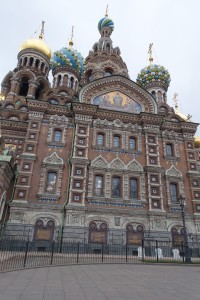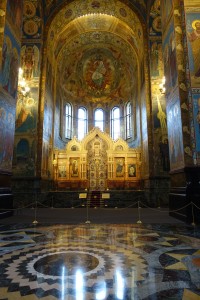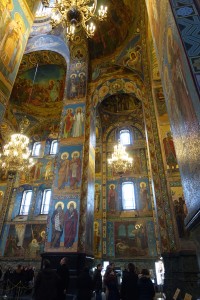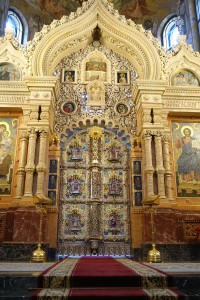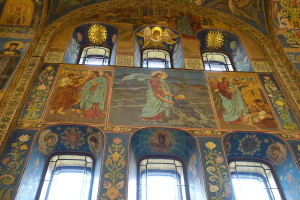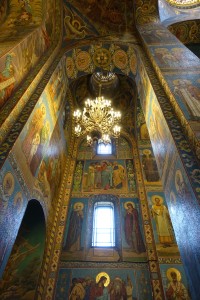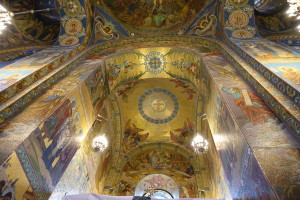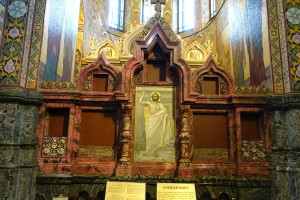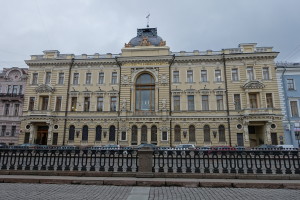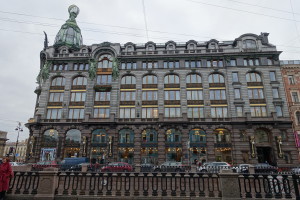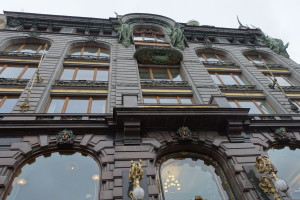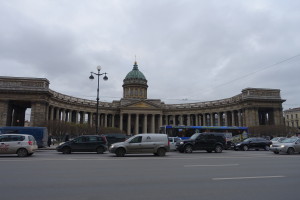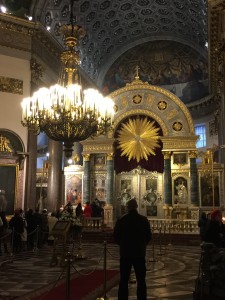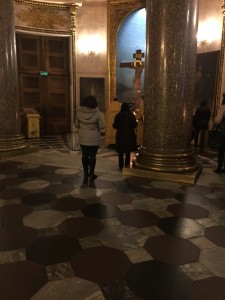
God in a Russian church?
Reading about this city, and learning a little of its history, is quite different from physically walking the streets, stepping into the sanctuaries or spending time with the people. Saint Petersburg is a beautiful bustling city and yet, I felt something important missing.
First of all, I do realize God doesn’t need a church to reside in a city. His presence is everywhere. In the Old Testament, King David understood: Psalm 139:7-8, “Where shall I go from your Spirit? Or where shall I flee from your presence? If I ascend to heaven, You are there; If I make my bed in Sheol, You are there.” David knew God is everywhere. I’m here in Russia…and God is here with me. But, how well do the people know God? Both the Old and New Testament confirm to us, (Joel 2:32, Acts 2:21 and Romans 10:13) “…everyone who calls on the name of the Lord will be saved.” Everyone. Jesus is His name. To call upon Him, we must first know His name.
Though the young women–custom’s agents–inspecting my luggage at the airport failed to recognize the very basic symbol of Jesus Christ, I hoped they were the “exception,” not the “rule.” Without recognizing the cross, how could they know His name?
Just a short one hundred years ago, Russia’s last Tsar, Nicholas II, considered the Christian Orthodox faith a key pillar for all Russian life.
More than five hundred years ago (1453) in the midst of the “dark ages,” Russia stepped up to protect the Orthodox church during the fall of Constantinople to the brutal Ottoman Empire of Turkey. After saving numerous sacred items from destruction–papyrus biblical scrolls, books on everything from science to medicine to historical records, and ceremonial Christian items–Russia considered itself the “center of Orthodox Christianity.” Without Russia’s intervention, all of Byzantium might have been lost as many Greek scholars and church leaders hurried towards the security of a strong Russia.
Going even further back into Russia’s history–over a thousand years ago (988)–the prince of Kievan Rus (Vladimir I) chose Christianity as their national religion. Thus, I believe christianity flows deep through the veins of this land. Just as my own country began under God, so did Russia. I need to understand. What changed the spiritual direction of this country?
As the last Tsar died during the Revolution in 1917, Russia moved from a “Nation under God” to one replacing God with science. First, the Bolsheviks destroyed many churches; abandoned others; and kept a few as symbols of Russian architecture and beauty. Next, new laws prevented people from gathering together publicly (within a structure) to worship God. Little by little, personal freedoms were replaced and removed by a forceful government interference including the freedom to know God Word.
Proverbs 29:18, “Where there is no prophetic vision the people cast off restraint, but blessed is he who keeps the law”
Without God’s leading and direction, everything spins into moral chaos. Not all churches disappeared. These grand structures remain. I intended to discover a few. But, instead of feeling the fullness of God’s presence, I felt an emptiness increase upon entering the famous St. Petersburg church, “Church of the Savior on Spilled Blood.”
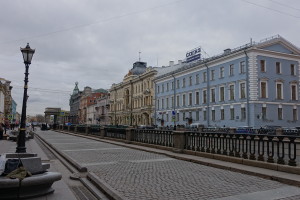
Church of the Savior on Spilled Blood in the distance as seen from the perspective of the Tsar’s carriage ride
The location of this church is different from most. Built upon the spot where Tsar Alexander II was murdered in 1881, this onion domed structure appears majestic against its surroundings. While riding in his carriage along the banks of this narrow waterway two separate assassins attacked him–both using explosives. Revolutionaries killed Alexander II because his new laws (emaciating serfs) failed to redistribute the amount of wealth demanded by the masses. (As in other countries, an old feudal system ruled Russia; it was just a matter of time before the great masses of peasants revolted against their nobility.)
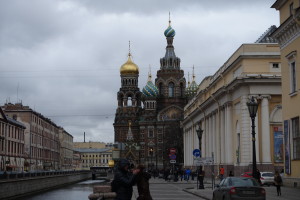
Built to commemorate this Tsar, on the place of his assassination, it was built as a memorial more than a church sanctuary.
Church of the Savior on Spilled Blood
This is the medieval Russia I longed to see–romantic and colorful with its churches topped with architectural domes. Similar to L’Hermitage, this church suffered from mobs ransacking and destroying it during Russia’s revolution. The Church contains over 7500 square meters of tiny mosaics (more than any other church in the world).
Nothing prepared me for actually seeing this amazing church in person. Pictures fail to depict the truly stunning interior. From the mosaic floors inlaid from semi-precious stones, domed ceilings and arched windows to the gold icons, ivory iconostasis, and crystal chandeliers, everything inside glimmers and shines.
With so much to see upon stepping inside, I didn’t know where to begin. Fortunately by purchasing the self guided tour (portable headphone), I followed the guided path on the recording instead of wandering around. From one area of the church to another I looked at each intricate mosaic image or scene all the while those gleaming faces peered back at me! I learned the history of this church; the expensive and unique materials used in its construction; the knowledge and abilities of the architects and builders; and the many talented artists and tradesmen necessary in this type of craftsmanship. Sadly, most of the Icons are missing—either stolen or destroyed during a revolution or government action—so the semi-precious stone Iconostasis stand nearly empty. I wanted to know more about the missing Icons. What did they depict, and where did they go?
The government closed up this church in 1930; already suffering extensive damaged, it became a morgue during WWII; and later converted into a vegetable warehouse. Restoration didn’t begin until 1970 with a reopening in 1997. Though this church once held memorial services in memory of the assassinated tsar, it now functions strictly as a museum.
It’s stunning to look at, but no mention of God or prayer. With a church of this one, failing to proclaim God to those who enter, how will anyone know of God’s name? This is just another museum (albeit unique and beautiful in every way)–built in tribute to an assassinated Tsar.
As I walked away from this church and followed the narrow roadway along the waterway, I “people watched:” women with fur trimmed coats and hats; men with caps with scarves wrapped around their necks; everyone wearing boots, gloves and all things necessary to shut out the frosty air. With my right arm still hurting from the fall in London, it felt good to finally keep it tucked inside the sleeves of a down filled coat.
The colorful buildings with detailed architectural elements kept my mind occupied despite the cold!
Many of these buildings were former palaces belonging to the nobility and built during Peter the Great’s construction of this city.
Cathedral of Our Lady of Kazan
When I first saw this cathedral, I didn’t realize it was a church. Unlike the previous church, this cathedral blends into the skyline around it. The two long semicircular colonnades flank the domed cathedral and hide entrance into the sanctuary.
In 1710, the holy Icon, “Our Lady of Kazan,” was brought to St. Petersburg by Peter the Great and considered the palladium of this city. Originally placed in a wooden church, “Nativity of the Virgin Mary,” it was later moved by Empress Anna into a stone one (on Nevsky Prospect) in 1737. Here Empress Catherine II became an Orthodox Christian and married her husband, Emperor Peter III. Though this church later gained the status “cathedral” it soon became dilapidated and a new one was needed. Thus, upon ascending the throne in 1796, Emperor Paul I ordered a new, larger cathedral to be built, at this site, to house their national icon.
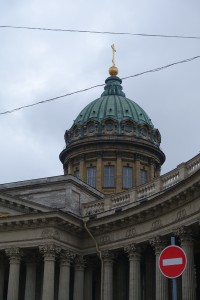
A “stop sign” caught in the camera’s lens as I photographed this church sanctuary. God is not stopped here.
It is not clear if this particular Icon, “Our Lady of Kazan,” is the one brought to St. Petersburg by Peter the Great or a duplicate copy since the original may have been lost or stolen during Russia’s revolution in 1917. After the Bolsheviks ascended into power, this cathedral descended into disrepair and devastation; the valuable icons and stands, liturgical vessels and silver decorations were confiscated by the Soviet government. Emptied and destroyed the cathedral closed in 1931 and then reopened a year later as the “Museum of the History of Religion and Atheism”–part of Russia’s Academy of Science. Despite the removal of God, joint use of the cathedral (combining both science with religion) occurred sixty years later (1991) after years of restoration to both exterior and interiors of this cathedral. The cross returned to the church dome. The Patriarch of Moscow established the status of the cathedral as a Metropolitan Church and the seat of the “Eparchy of St. Petersburg.”
But not until July 21, 2002, did the Icon, “Our Lady of Kazan” finally return to its rightful place in the main iconostasis of the Kazan Cathedral. Today (like most days) a long line formed in front of the holy Icon with people either wanting a closer look or those needing a blessing or miracle in their life.
Quietly to the side of this expansive cathedral, a priest, robed in a simple Orthodox garment, performed a daily mass with only a few standing in attendance. He moved about speaking quietly while offering up petitions and prayers; a smoking brass censer, containing a sweet smelling incense, swung from his hands. After completing the midweek service he turned and provided an opportunity for those present to come and receive a blessing.
Lighting a tall, tapered candle, I placed it into a sand filled space beneath the Cross and prayed for this land. This city cannot deny our Almighty God. He is here. Despite a government’s attempts to rid their land of God, He is here.
Even Blaise Pascal (French Mathematician, Philosopher and Physicist, 1623-1662) understood this when he said, “There is a God shaped vacuum in the heart of every man which cannot be filled by any created thing, but only by God, the Creator, made known through Jesus.”
Science and God do exist together; the heavens and earth were created by God. Perhaps it is man that creates the contradiction and suffers when He denies God’s existence? The Creation knows the Creator:
Romans 1:20, “For his invisible attributes, namely, his eternal power and divine nature, have been clearly perceived, ever since the creation of the world, in the things that have been made. So they are without excuse.”
There is a yearning inside each of us, longing to know God. A place where only He can fill. Denying His existence doesn’t change God, it keeps us from knowing Him.
This is a beautiful city, dedicated to God by Peter the Great and each successive Tsar or Empress thereafter. But the revolution one hundred years ago crushed both the “head” (nobility) and soul (God’s sanctuaries) of this country. But, God’s presence remains. He never leaves us.
Two churches–one a museum and the other, the official church of St. Petersburg–with two vastly different experiences. Without preconceived ideas, I am open to discover whatever God reveals to me as I walk with Him in this land.
